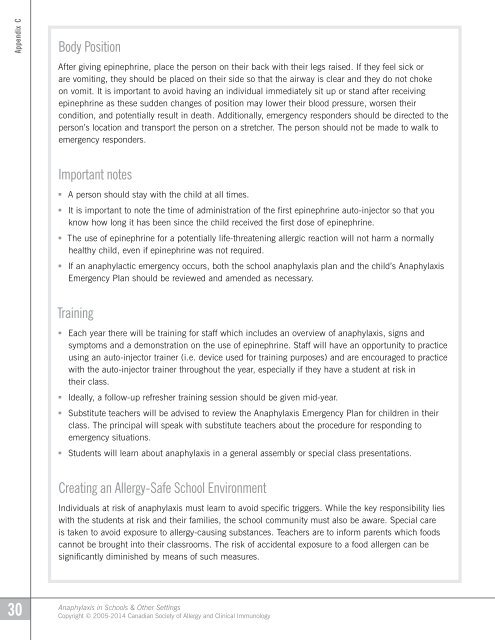Anaphylaxis in Schools 3rd Edition
Anaphylaxis in Schools 3rd Edition
Anaphylaxis in Schools 3rd Edition
Create successful ePaper yourself
Turn your PDF publications into a flip-book with our unique Google optimized e-Paper software.
Appendix C<br />
Body Position<br />
After giv<strong>in</strong>g ep<strong>in</strong>ephr<strong>in</strong>e, place the person on their back with their legs raised. If they feel sick or<br />
are vomit<strong>in</strong>g, they should be placed on their side so that the airway is clear and they do not choke<br />
on vomit. It is important to avoid hav<strong>in</strong>g an <strong>in</strong>dividual immediately sit up or stand after receiv<strong>in</strong>g<br />
ep<strong>in</strong>ephr<strong>in</strong>e as these sudden changes of position may lower their blood pressure, worsen their<br />
condition, and potentially result <strong>in</strong> death. Additionally, emergency responders should be directed to the<br />
person’s location and transport the person on a stretcher. The person should not be made to walk to<br />
emergency responders.<br />
Important notes<br />
• A person should stay with the child at all times.<br />
• It is important to note the time of adm<strong>in</strong>istration of the first ep<strong>in</strong>ephr<strong>in</strong>e auto-<strong>in</strong>jector so that you<br />
know how long it has been s<strong>in</strong>ce the child received the first dose of ep<strong>in</strong>ephr<strong>in</strong>e.<br />
• The use of ep<strong>in</strong>ephr<strong>in</strong>e for a potentially life-threaten<strong>in</strong>g allergic reaction will not harm a normally<br />
healthy child, even if ep<strong>in</strong>ephr<strong>in</strong>e was not required.<br />
• If an anaphylactic emergency occurs, both the school anaphylaxis plan and the child’s <strong>Anaphylaxis</strong><br />
Emergency Plan should be reviewed and amended as necessary.<br />
Tra<strong>in</strong><strong>in</strong>g<br />
• Each year there will be tra<strong>in</strong><strong>in</strong>g for staff which <strong>in</strong>cludes an overview of anaphylaxis, signs and<br />
symptoms and a demonstration on the use of ep<strong>in</strong>ephr<strong>in</strong>e. Staff will have an opportunity to practice<br />
us<strong>in</strong>g an auto-<strong>in</strong>jector tra<strong>in</strong>er (i.e. device used for tra<strong>in</strong><strong>in</strong>g purposes) and are encouraged to practice<br />
with the auto-<strong>in</strong>jector tra<strong>in</strong>er throughout the year, especially if they have a student at risk <strong>in</strong><br />
their class.<br />
• Ideally, a follow-up refresher tra<strong>in</strong><strong>in</strong>g session should be given mid-year.<br />
• Substitute teachers will be advised to review the <strong>Anaphylaxis</strong> Emergency Plan for children <strong>in</strong> their<br />
class. The pr<strong>in</strong>cipal will speak with substitute teachers about the procedure for respond<strong>in</strong>g to<br />
emergency situations.<br />
• Students will learn about anaphylaxis <strong>in</strong> a general assembly or special class presentations.<br />
Creat<strong>in</strong>g an Allergy-Safe School Environment<br />
Individuals at risk of anaphylaxis must learn to avoid specific triggers. While the key responsibility lies<br />
with the students at risk and their families, the school community must also be aware. Special care<br />
is taken to avoid exposure to allergy-caus<strong>in</strong>g substances. Teachers are to <strong>in</strong>form parents which foods<br />
cannot be brought <strong>in</strong>to their classrooms. The risk of accidental exposure to a food allergen can be<br />
significantly dim<strong>in</strong>ished by means of such measures.<br />
30<br />
<strong>Anaphylaxis</strong> <strong>in</strong> <strong>Schools</strong> & Other Sett<strong>in</strong>gs<br />
Copyright © 2005-2014 Canadian Society of Allergy and Cl<strong>in</strong>ical Immunology


